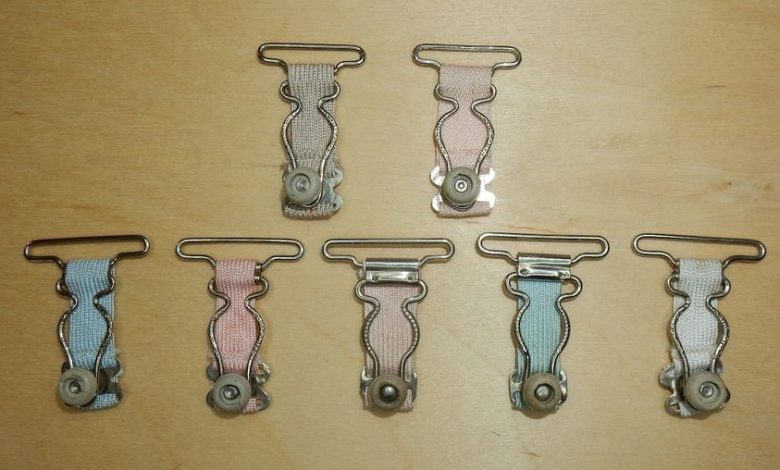
ADVERTISEMENT
From Functionality to Fashion: The Enduring Legacy of Vintage Garter Clips
Introduction
In the ever-evolving world of fashion, certain items transcend their original purpose to become iconic symbols of an era. Vintage garter clips, once simple tools of practicality, have emerged as fascinating relics of the past, embodying both the elegance and the ingenuity of early 20th-century fashion. These small yet significant accessories, often overlooked in the broader narrative of fashion history, tell a story of societal norms, technological advancements, and the delicate balance between functionality and style.
The Historical Significance of Garter Clips
Garter clips first gained prominence in the late 19th and early 20th centuries, a time when the fashion industry was undergoing rapid changes. The Victorian era’s emphasis on modesty and propriety led to the widespread use of garters, which were essential for holding up stockings in an age before elasticated fabrics were common. Garter clips, therefore, were not merely accessories; they were necessities, ensuring that stockings stayed in place throughout the day.
Initially, garter clips were purely functional, designed to be hidden beneath layers of clothing. They were made from durable materials such as metal and sturdy fabrics to withstand daily wear. However, as fashion began to evolve, so too did the design of garter clips. They started to feature intricate designs, with delicate engravings, and were often adorned with decorative elements, reflecting the growing importance of aesthetics in everyday accessories.
The Role of Garter Clips in Early 20th-Century Fashion
As the 20th century progressed, garter clips became increasingly popular among women, particularly during the 1920s and 1930s. This period, often referred to as the “Golden Age of Fashion,” saw a shift towards more liberated styles. Women’s clothing became less restrictive, and the hemlines of dresses rose, exposing the legs and, by extension, the stockings. Garter clips, once hidden, became visible and thus a part of the overall fashion statement.
The Art Deco movement, with its emphasis on geometric shapes and luxurious materials, had a significant influence on the design of garter clips during this time. Clips were often crafted with fine metals and featured elaborate designs, making them both functional and fashionable. Women of the era took pride in their garter clips, which were seen as symbols of sophistication and modernity.
ADVERTISEMENT
Cultural Implications and Symbolism
Garter clips, though small, carried significant cultural implications. They were associated with femininity and, in some circles, with sensuality. The act of fastening a garter was imbued with a certain allure, often depicted in the media of the time. However, garter clips also represented the changing roles of women in society. As women gained more independence and began to take on roles outside the home, their fashion choices reflected this newfound freedom. Garter clips, once hidden, became a symbol of this shift, representing both practicality and personal expression.
The Decline and Revival of Garter Clips
The advent of nylon stockings and the development of elastic materials in the mid-20th century led to the decline of garter clips as everyday necessities. Stockings that could stay up on their own became the norm, rendering garter clips somewhat obsolete. However, they never disappeared entirely. Instead, garter clips found a new life in the world of vintage fashion and as collectibles.
Today, vintage garter clips are prized by collectors and fashion enthusiasts alike. They are seen as nostalgic pieces, reminders of a bygone era when fashion was as much about the hidden details as it was about the visible garments. These clips are often showcased in vintage clothing stores, antique shops, and fashion museums, where they are appreciated not only for their beauty but also for their craftsmanship.
Modern Reflections on Vintage Fashion
In contemporary fashion, there is a growing appreciation for vintage items, including garter clips. This resurgence can be attributed to several factors: a desire for sustainable fashion, a fascination with the past, and a recognition of the artistry involved in creating these pieces. Garter clips, with their unique blend of functionality and elegance, embody the timeless appeal of vintage fashion.
Moreover, the modern fashion industry has begun to reimagine garter clips, incorporating them into new designs that pay homage to the past while embracing the future. Designers have experimented with modern materials and technologies, creating garter-inspired accessories that serve both as a nod to history and as contemporary fashion statements.
ADVERTISEMENT
Conclusion
The journey of garter clips from practical tools to fashion icons is a testament to the evolving nature of fashion and society. These small accessories, once essential for holding up stockings, have become cherished symbols of an era defined by elegance, innovation, and changing social norms. As we continue to explore the intersections of fashion, history, and culture, vintage garter clips remind us that even the most functional items can hold deep significance and enduring beauty.
In an age where fast fashion often dominates, the revival of interest in vintage pieces like garter clips is a refreshing reminder of the value of craftsmanship and the stories embedded in the accessories of the past. Whether worn as part of a vintage ensemble or collected as a piece of history, garter clips remain a fascinating and enduring legacy of fashion’s rich and diverse heritage.
This article combines historical analysis, cultural reflection, and modern perspectives to create a unique narrative centered around vintage garter clips. If you have any additional details or specific areas you’d like to explore further, feel free to let me know!
ADVERTISEMENT




